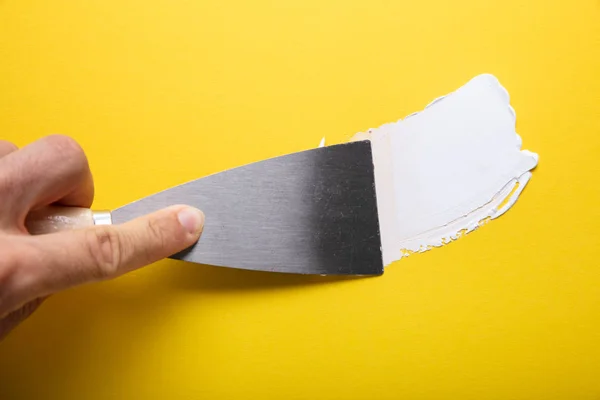Mastering Use of the Flexible Putty Knife: A Comprehensive Guide
A flexible putty knife is a seemingly simple yet highly versatile tool that finds its place in numerous repair and renovation tasks. With its thin, flat, and flexible blade, this unassuming hand tool can accomplish a wide range of applications with ease. From smoothing surfaces to removing unwanted materials, a flexible putty knife proves to be an indispensable companion for both professionals and DIY enthusiasts. Let’s delve into the various applications of a flexible putty knife and understand why it’s a must-have in every toolbox. We will also provide a step-by-step guide on how to use a flexible putty knife effectively and efficiently.
If you need help finding a flexible putty knife for any of the versatile applications listed below, see our product review article here.
Exploring the Versatile Applications of a Flexible Putty Knife
Patching and Repairing Drywall
One of the primary applications of a flexible putty knife is patching and repairing drywall. Whether it’s covering small nail holes, filling cracks, or fixing larger holes, the flexibility of the blade allows for smooth and precise application of joint compound or spackle. With the right technique, you can achieve a seamless finish, making the repaired area virtually indistinguishable from the surrounding surface.
Scraping Off Old Paint and Wallpaper
Removing old paint or wallpaper can be a tedious task, but a flexible putty knife makes it much more manageable. Its thin and flexible blade allows it to slide under paint chips or wallpaper, gently lifting them off the surface without causing damage. By applying consistent pressure, you can effectively strip away old layers and prepare the surface for a fresh coat of paint or new wallpaper.
Applying and Smoothing Caulk and Adhesive
When it comes to precise application of caulk or adhesive, a flexible putty knife proves invaluable. The blade’s flexibility enables you to spread caulk smoothly along seams, corners, or edges. It ensures an even distribution and helps create a tight seal, preventing leaks and drafts. Similarly, when working with adhesive, the putty knife allows you to apply it precisely without smearing or wasting excess material.
Spackling and Filling Holes
Filling holes and imperfections in walls, woodwork, or other surfaces requires precision and control. A flexible putty knife provides just that. Whether it’s spackling a small dent or filling larger voids, the thin blade ensures an even application of the filler material. It allows you to feather the edges smoothly, achieving a seamless blend with the surrounding surface.
Applying Wood Filler and Epoxy
In woodworking projects, a flexible putty knife is invaluable for applying wood filler or epoxy. The flexibility of the blade enables you to work on uneven surfaces and mold the filler to match the contours of the wood. It’s an essential tool for restoring damaged or weathered woodwork, ensuring a professional and refined finish.
Cleaning and Removing Residue
Beyond repair and renovation tasks, a flexible putty knife proves useful for cleaning and removing stubborn residue. It can scrape off dried adhesives, wax, gum, or stickers from various surfaces without scratching or damaging them.
Arts and Crafts
Artists and crafters also appreciate the versatility of a flexible putty knife. It can be used for creating textures in paintings, applying modeling paste, or spreading glue for crafting projects.
In conclusion, a flexible putty knife is a multi-functional tool that excels in a myriad of applications. Its ability to spread, smooth, and remove materials with precision makes it an essential addition to any toolkit. From repairing drywall to scraping off old paint, its uses are limited only by your imagination. Whether you’re a professional contractor or a DIY enthusiast, having a reliable flexible putty knife will undoubtedly enhance the quality and efficiency of your repair and renovation projects.
Step-By-Step Guide on How to Use a Flexible Putty Knife Effectively and Efficiently
Using a flexible putty knife effectively and efficiently requires the right technique and a bit of practice. Whether you’re patching drywall, scraping paint, or applying caulk, following these step-by-step guidelines will help you make the most of this versatile tool:
Step 1: Choose the Right Size
Select the appropriate size of the flexible putty knife based on the task at hand. For small repairs or detailed work, opt for a narrow blade (around 1 inch). For general applications, a 2 to 3-inch blade is versatile, while larger blades (4 inches or more) are suitable for covering larger areas quickly.
Step 2: Prepare the Surface
Before using the putty knife, ensure the surface is clean, dry, and free of loose debris. Remove any old paint, wallpaper, or caulk as needed. If you’re patching drywall, sand the area lightly to create a smooth surface for the filler.
Step 3: Apply the Material
For patching and repairs, load the flexible putty knife with joint compound, spackle, or filler. Scoop a small amount of the material onto the blade.
Step 4: Smooth Application
Hold the putty knife at a slight angle (around 30 degrees) to the surface and apply the material evenly over the damaged or uneven area. Use smooth, gentle strokes to spread the material, working from the center outward. For larger areas, overlap the strokes to ensure a uniform coverage.
Step 5: Feather the Edges
When patching drywall or filling holes, feather the edges of the applied material. This involves using a lighter touch and gradually decreasing pressure towards the edges. Feathering ensures a seamless blend with the surrounding surface, making the repair less visible.
Step 6: Scrape Off Excess Material
If you’ve applied too much material or there are ridges, use the putty knife’s edge to scrape off the excess. Hold the blade almost flat against the surface and gently glide it over the excess material, leaving a smooth and even finish.
Step 7: Clean the Putty Knife
After each use, clean the flexible putty knife thoroughly with water (for water-based materials) or mineral spirits (for oil-based materials). Wipe off any residue and dry the blade before storing it to prevent rusting.
Step 8: Practice Makes Perfect
Using a flexible putty knife efficiently takes practice. Experiment with different angles, pressures, and techniques on scrap materials before tackling actual projects. The more you use the tool, the better you’ll become at achieving smooth and professional results.
Step 9: Safety Tips
- Always wear appropriate safety gear, such as gloves and safety goggles, to protect yourself during tasks.
- When scraping off old paint or caulk, be cautious of lead-based paint and follow proper safety protocols if dealing with older surfaces.
By following these step-by-step guidelines and honing your skills, you’ll be able to use a flexible putty knife effectively and efficiently, achieving impressive results in your repair and renovation projects.
Frequently Asked Questions
What should I never do with a flexible putty knife?
While a flexible putty knife is a versatile and handy tool, there are certain actions you should avoid to ensure its proper and safe use. Here are some things you should never do with a flexible putty knife:
- Using it as a Screwdriver or Pry Bar: A flexible putty knife is not designed for heavy-duty tasks like prying open lids, removing nails, or functioning as a screwdriver. Using it for such purposes can damage the blade, handle, or compromise the tool’s overall integrity.
- Applying Excessive Force: Avoid applying excessive force on the blade, especially when using a plastic putty knife. Overly bending or flexing the blade can lead to deformation or breakage.
- Using on Hot Surfaces: Do not use a plastic putty knife on hot surfaces or expose it to high temperatures. The plastic material may soften, warp, or melt under heat.
- Scraping Hardened or Stubborn Materials: While flexible putty knives can handle light scraping, avoid using them on materials that are too hard or stubborn, as it may damage the blade or reduce its flexibility.
- Neglecting Proper Maintenance: After each use, clean the putty knife thoroughly to remove any leftover materials. If using a metal putty knife, dry it properly to prevent rusting. Neglecting maintenance can reduce the lifespan of the tool.
- Using on Electrical Outlets or Live Wires: Never use a putty knife near electrical outlets or live wires. It is not an insulated tool and can pose an electrical hazard.
- Working without Proper Safety Gear: When using a flexible putty knife, wear appropriate safety gear, such as gloves and safety goggles, to protect yourself from potential injuries.
- Leaving it within Reach of Children: Always store your putty knife safely out of the reach of children. They should only be handled by responsible individuals who understand how to use them properly.
- Applying Too Much Pressure on Plastic Knives: Plastic putty knives are not as durable as metal ones, so avoid using excessive pressure, which can lead to bending or breaking the blade.
- Using it on Sharp or Abrasive Surfaces: Avoid using the putty knife on surfaces with sharp edges or abrasive materials that can damage the blade.
By avoiding these actions, you can prolong the life of your flexible putty knife and ensure safe and effective use in various repair and renovation tasks. Always follow the manufacturer’s guidelines and use the tool as intended to achieve the best results and maintain its longevity.
Why is a flexible putty knife flexible to begin with?
A flexible putty knife is designed with a thin and bendable blade to allow for better control and smoother application of materials. The flexibility of the blade is a crucial feature that serves several purposes in various repair and renovation tasks. Here are the primary reasons why a putty knife is made flexible:
- Conforming to Uneven Surfaces: Flexible putty knives can bend and adapt to the contours of uneven surfaces, such as drywall, wood, or other materials. This ability allows the blade to follow the curves and irregularities of the surface, ensuring even and consistent application of putty, joint compound, spackle, or other materials.
- Precise Application: When patching small holes, filling cracks, or smoothing out imperfections, a flexible blade provides greater control. It allows users to apply the material precisely without leaving excess or creating ridges.
- Smoothing and Feathering Edges: Feathering the edges of applied materials is a common technique in repair and renovation tasks. By gently reducing pressure towards the edges of the blade, the flexible putty knife can seamlessly blend the filler material with the surrounding surface, resulting in a smooth and natural finish.
- Reducing the Risk of Damage: The flexibility of the blade helps prevent damage to delicate surfaces, such as drywall or wood. By bending rather than exerting excessive force, a flexible putty knife is less likely to scratch or dent the surface, making it a safer choice for working on sensitive materials.
- Enhanced Maneuverability: A flexible blade allows users to work comfortably in tight or confined spaces. The ability to bend and adjust the angle of the blade makes it easier to navigate corners, edges, and hard-to-reach areas.
- Versatility: The flexibility of the blade makes a putty knife suitable for a wide range of materials, including joint compound, spackle, caulk, adhesive, paint, and more. This versatility allows users to use the same tool for various repair and renovation tasks.
- Reducing Fatigue: The flexibility of the blade can also help reduce hand fatigue during prolonged use. It allows users to work with a lighter touch while achieving effective results.
Overall, the flexibility of a putty knife’s blade is a fundamental feature that enables users to work with greater precision, control, and versatility. It makes the tool well-suited for a variety of applications and ensures smoother and more professional outcomes in repair and renovation projects.
What are some alternatives to a flexible putty knife?
While a flexible putty knife is a versatile tool for various repair and renovation tasks, there are several alternatives that you can use depending on the specific job and materials involved. Here are some common alternatives:
- Rigid Putty Knife: As the opposite of a flexible putty knife, a rigid putty knife has a stiffer blade that is less flexible. It is suitable for tasks that require more force and where precise application is not critical. Rigid putty knives are commonly used for scraping off old paint, removing wallpaper, or other tasks where a more rigid blade is advantageous.
- Utility Knife: A utility knife with a sharp blade can be used for cutting and trimming materials like caulk, wallpaper, or painter’s tape. While not suitable for spreading materials like a putty knife, it is useful for precision cutting and fine detail work.
- Spatula: In certain cases, a kitchen spatula can serve as a makeshift putty knife for light-duty applications, especially when dealing with soft and spreadable materials like frosting, adhesive, or putty. However, it is essential to ensure that the spatula is clean and free of any food residues before using it for DIY tasks.
- Painter’s Putty Knife: A painter’s putty knife is similar to a flexible putty knife but may have a slightly different design or handle. It is commonly used for applying and smoothing paint, caulk, and other painting materials. While it may not be as flexible as a dedicated putty knife, it can still perform some repair and renovation tasks.
- Plastic Spreader: Plastic spreaders are inexpensive and come in various sizes, making them suitable for light-duty tasks like applying spackle, filler, or adhesives. They are gentler on delicate surfaces and may not be as durable as metal putty knives, but they can get the job done for smaller projects.
- Fingers or Gloves: In some cases, such as applying caulk to small gaps or seams, using your fingers (protected by gloves) can be an effective alternative to a putty knife. This method allows for better control and direct contact with the material, especially for precise work.
- Brush or Roller: While not a direct alternative, brushes and rollers are essential tools for painting tasks. They can be used to apply paint or primer to large surfaces, while a putty knife is more suitable for small-scale repairs and touch-ups.
It’s important to note that while these alternatives can be useful in certain situations, they may not always provide the same level of control, precision, or versatility as a dedicated flexible putty knife. For professional and more extensive repair projects, investing in a quality flexible putty knife is still recommended.
editor's pick
news via inbox
Stay one step ahead with exclusive tips, guides, and offers delivered directly to your inbox.
Sign up for our newsletter and elevate your home improvement game today!


